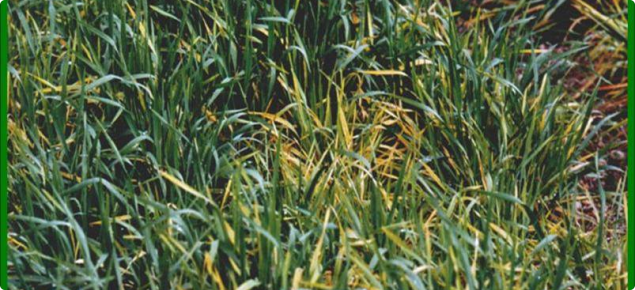Insecticides for BYDV vector control
- Assess your own BYDV risk this season (for example, presence of green bridge) before deciding if insecticides are necessary.
- It is vital to prevent spread of BYDV during the first 8-10 weeks after crop emergence, as this is when plants are most vulnerable to the effects of the virus. Low numbers of aphids can spread the disease in high risk areas.
- Standard rates of insecticides are recommended for use early in the season in high risk areas to deter aphids from spreading virus when feeding on the cereal crop.
- Where two different insecticide rates are recommended, the lower rate is sufficient in most circumstances.
| Active ingredient | Product | Rate per hectare | Remarks |
|---|---|---|---|
| Alpha-cypermethrin (100g/L) | various | 125 | Apply at three and seven weeks after emergence to reduce aphid colonisation and spread of BYDV |
| Chlorpyrifos (300g/L) and L-cyhalothrin (15.4g/L g/L) | Cobalt | 200 or 300 | Apply sprays four and eight weeks after emergence to reduce aphid colonisation |
| Esfenvalerate (50g/L) | Sumi-alpha | 100-300mL | Use high rate in high risk areas, apply three and seven weeks post emergence |
| Gamma-cyhalothrin (150g/L) | Trojan | 10 or 15mL | Apply sprays four and eight weeks after emergence to reduce aphid colonisation |
| Lambda-cyhalothrin (250g/L) | various | 12 or 18mL | Apply sprays four and eight weeks after emergence to reduce aphid colonisation |
| Sulfoxaflor | Transform | 50-100mL | Use higher rate under heavy aphid infestations and/or when water volume is reduced, such as with aerial application. Do not apply more than twice in crop. |
| Active ingredient | Products | Rate per kg seed | Remarks |
|---|---|---|---|
| Imidacloprid 600g/L | various | 120 or 240mL/100kg seed | Higher rate for increased length of control in high risk areas. A synthetic pyrethroid top-up spray is recommended to be applied 7-8 weeks after sowing imidacloprid treated seed for control of aphids vectoring barley yellow dwarf virus (BYDV) |
| Thiamethoxam (350g/L) | Cruiser | 100-200mL/100kg seed | Use the higher rate in areas where higher pest pressure is expected or a longer period of control is required. |
| Thiamethoxam (210g/L) + Lambda-cyhalothrin (37.5g/L) | Cruiser Opti, Kenso | 165-330mL/100kg seed | Higher rate in areas where higher pest pressure is expected or longer period of control required |
Insecticides for aphid feeding damage control
- Direct feeding damage occurs when colonies of aphids develop on stems, leaves and heads, usually in the tillering and later stages of crop growth through to head filling.
- Once aphid populations become established in a crop, higher rates of insecticides are required to reduce high aphid populations and to minimise their feeding damage.
- The recommended threshold for corn and oat aphid is to apply insecticide is 50% of cereal tillers have 15 or more aphids and crops are expected to yield three tonnes/ha or more.
- The recommended threshold for Russian wheat aphid depends on the percentage of tillers with aphids and the growth stage. See the threshold calculator to determine if crops need to be sprayed.
| Active ingredient | Product | Rate per hectare | Remarks |
|---|---|---|---|
| Afidopyropen* | Versys | 50 | Apply maximum of two sprays in season. Do not apply after GS71 (watery ripe) |
| Chlorpyrifos (300g/L) and L-cyhalothrin (15.4g/L) | Cobalt | 200 or 300mL | Use higher rates if threshold is exceeded |
| Dimethoate (400g/L) | various | 500mL | |
| Gamma-cyhalothrin (150g/L) | Trojan | 10-15mL | Use higher rates if threshold is exceeded |
| Lambda-cyhalothrin* (250g/L) | various | 12-18mL | Use higher rates if threshold is exceeded |
| Pirimicarb* (800g/kg) | various | 160-190g | Apply if aphids have reached threshold and crop is between emergence of last leaf and flowering stages. Application of pirimicarb at temperatures greater than 15°C may give better control. |
| Sulfoxaflor* (240g/L) | Transform | 50-100mL | Do not apply more than twice in season. Do not apply to crop later than the flag leaf stage |
| Sulfoxaflor* (500g/L) | Expedite | 25-50mL | Do not apply more than twice in season. Do not apply to crop later than the flag leaf stage |
Note asterix (*) indicates Russian wheat aphid is mentioned on the chemical label and use highest rate for control
Disclaimer
The insecticides listed are emulsifiable concentrates (EC). Any omission of an insecticide or trade name is unintentional. The mention of trade names does not imply endorsement or preference for any company’s product by the Department of Primary Industries and Regional Development. The recommendations/registrations are valid at time of publishing.


